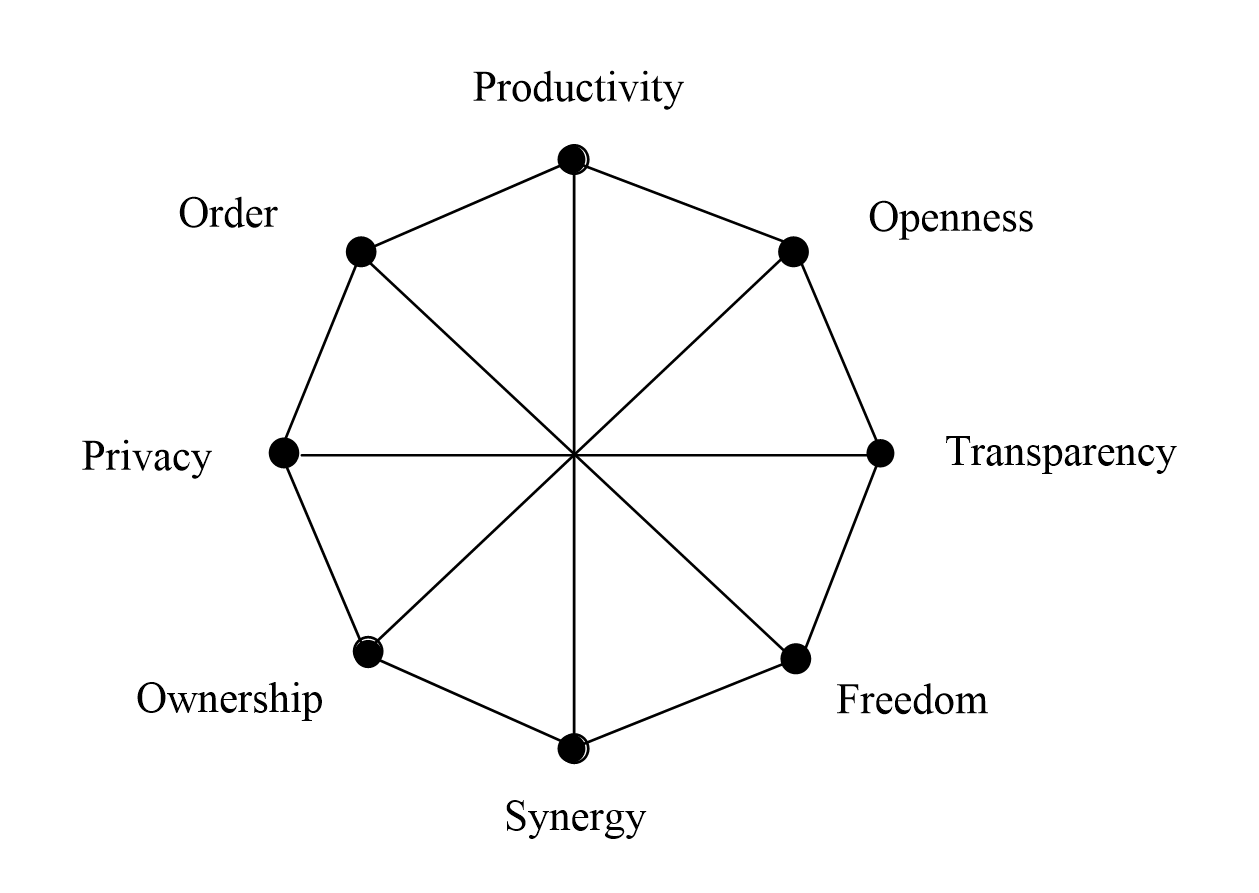
Communities interact with others, using spies to act as “eyes”, diplomats to communicate, engineers to effect, soldiers to defend, intellectuals to adapt and traders to extend, but a community can also interact with itself, to communicate or synergize, as follows (Figure 3.3):
1) Productivity. As functionality is what a system can produce, so communities produce bridges, art and science by citizen competence, based on education of knowledge, ethics and tacit skills. Help and FAQ systems illustrate this for an online community.
2) Synergy. As usability is less effort per result, so communities improve efficiency by synergy based on trust. In a society, if everyone gives, everyone gets, but if everyone takes, everyone is taken from. Public goods like roads and hospitals involve functional specialists giving to all. If all citizen specialists offer their services to others, all get more for much less effort. Wikipedia illustrates online synergy, as many specialists give a little knowledge so that all get a lot of knowledge.
3) Freedom. As flexibility is a system’s ability to change to fit a changing environment, so communities become flexible when citizens have freedom, i.e. the right to act autonomously. This is the right not to be a slave. The problem with competition is that if you give peanuts you get monkeys but if you give honey you get wasps. Freedom allows local resource control, which increases social performance just as decentralized protocols like Ethernet improve network performance.
4) Order. Reliability is a system’s ability to survive internal part failure or error. A community achieves reliability through order, when citizens, by rank, role or job, know and do their duty. Some cultures set up warrior or merchant castes to achieve this. Online order is also by roles, e.g. Sysop or Editor.
5) Ownership. Security is a system’s defense against outside takeover. A community is made secure internally by ownership, as to “own” a house guarantees that if another takes it, the community will step in. State ownership, as in communism or tribalism, is still ownership. Only if a state gives its ownership away do citizens get freedom Online, ownership works by access control (see Chapter 6).
6) Openness. Extendibility is a system’s ability to use what is outside itself. A community doing this is illustrated by America’s invitation to the world:
“Give me your tired, your poor, your huddled masses yearning to breathe free”.
A society is open internally if any citizen can achieve any role by merit, just as Abraham Lincoln, born in a log cabin, became US president. The opposite is nepotism or cronyism, giving jobs to family or friends regardless of merit. If community advancement is by who you know, not what you know, performance reduces. Open source systems like Source Forge let people advance by merit.
7) Transparency. As connectivity lets a person communicate with others, so transparency lets a community communicate with itself by media like TV, newspapers, radio and now the Internet. In a transparent community, people can easily see what the group is doing but in an opaque one they cannot. Transparent governance lets citizens view public money spent and privileges given, as public acts on behalf of a community are not private. Systems like Wikipedia illustrate transparency online.
8) Privacy. Privacy as a citizen’s right to control their personal information can also describe a community right given to all citizens, i.e. the same term works at the community level. In this case, it includes communication privacy, the right not to be monitored without consent.
Note some of the design tensions involved here:
- Productivity vs. synergy. Both require citizen participation, based on skills and trust respectively, yet are also in tension as one invokes competition and the other cooperation. The former improves how citizen “parts” perform and the latter how they interact. Service by citizens reconciles productivity and synergy, as it invokes both.
- Freedom vs. order. Both are in tension, as freedom has no class but order does. The social invention of democracy merges freedom and order by letting citizens chose their governance, not just of the President or Prime Minister, but for all positions. Democracy is rare online, but Slashdot uses it.
- Ownership vs. openness. Both are in tension, as the right to keep out denies the right to go in. Fairness can reconcile public access and private control. Offline fairness is supported by justice systems but online fairness must be supported by code.
- Transparency vs. privacy. Both are in natural tension, as giving the right to see another may deny their right not to be seen. Politeness reconciles this tension by letting people of different rank, education, age and experience connect. Further details are given in Chapter 4.
The social invention of rights can also reconcile many aspects of the web of social performance as discussed in Chapter 6. In the web of social performance, a community increases citizen competence to be productive, increases trust to get synergy, gives freedoms to adapt and innovate, establishes order to define responsibilities, allocates ownership to prevent property conflicts, is open to outside and inside talent, communicates internally to generate agreement, and grants legitimate rights that stabilize social interaction. Sexism and racism are community level losses. If women cannot work, half the population cannot add to its productivity. If a race, like black people, are excluded, so are their contributions. All these requirements together increase social performance, but they are in design tension, so each community must define its own social structure, whether online or off.